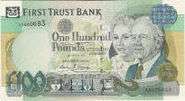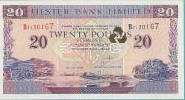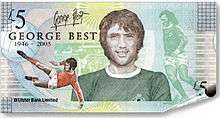Banknotes of Northern Ireland
Banknotes have been issued for use specifically in Northern Ireland since 1929, and are denominated in pounds sterling. They are legal currency, but technically not legal tender anywhere (including Northern Ireland itself).[1] However, the banknotes are still widely accepted as currency by larger merchants and institutions elsewhere in the United Kingdom. Issuing banks have been granted legal rights to issue currency, and back the notes with deposits at the Bank of England.
The issuing of banknotes in Northern Ireland is regulated by the Currency and Bank Notes Act 1928, the Coinage Act 1971, Banknotes (Ireland) Act 1864 (c. 78), Banknotes (Ireland) Act 1920 (c. 24), Bankers (Ireland) Act 1845, Bankers (Northern Ireland) Act 1928 (c. 15), among others.
Pursuant to some of these statutes, Her Majesty's Revenue and Customs publishes in the Belfast Gazette an account of "the Amount of Notes authorised by Law to be issued by the several Banks of Issue in Northern Ireland, and the Average Amount of Notes in Circulation, and of Bank of England Notes and Coin held"; see for example Issue 6800 published on 8 September 2006 at page 5874.[2]
Issuers
| Bank of Ireland | 1929– | ||||
| Belfast Banking Company | 1929–1968[n 1] | ||||
| National Bank | 1929–1959[n 2] | ||||
| Northern Bank | 1929–2012 | Danske Bank | 2013–[n 3] | ||
| Provincial Bank of Ireland | 1929–1981 | Allied Irish Bank | 1982–1993 | First Trust Bank | 1994–[n 4] |
| Ulster Bank | 1929– | ||||
- ↑ Acquired by Northern Bank in 1970.
- ↑ Acquired by Bank of Ireland in 1965.
- ↑ The Northern Bank was rebranded with the name of its parent company, Danske Bank, in 2012. Danske Bank notes were first issued in Northern Ireland in June 2013.[3]
- ↑ The Provincial Bank of Ireland was renamed the Allied Irish Bank in 1982, and then became the First Trust Bank in 1994, when AIB merged its Northern Ireland operations with those of TSB.
Denominations
Notes were initially issued in denominations of 1, 5, 10, 20, 50 and 100 pounds. Of these denominations, only the 1 pound has ceased to be issued, by all banks with the last produced by the Allied Irish Bank in 1984. The 5 pound note is only issued now by Bank of Ireland and Danske Bank stopped issuing notes over £20 when it rebranded.
Bank of Ireland notes

Until April 2008, all Bank of Ireland notes featured Queen's University of Belfast on the reverse side. A new series of £5, £10 and £20 notes was issued in May 2008, all featuring an illustration of the Old Bushmills Distillery, and these notes will gradually replace the previous series.[4][5]
The various denominations are differentiated by their colour and size:
- 5 pound note, blue
- 10 pound note, pink
- 20 pound note, green
- 50 pound note, blue-green.
First Trust Bank notes

First Trust Bank is a subsidiary of the Allied Irish Banks (AIB). It was formed by the 1991 merger of AIB with TSB Northern Ireland. AIB was the successor to the Provincial Bank of Ireland following another merger. The banknotes issued by First Trust Bank continue the series originally issued by the Provincial Bank of Ireland and subsequently by Allied Irish Banks.
First Trust Bank's current notes have a generic depiction of a Northern Irish person. A young middle-aged man appears on the £10 note, an elderly woman on the £20 note, an elderly man on the £50 note, and finally both elderly people together on the £100 note. The obverse designs generally feature images associated with the Spanish Armada, commemorating the wrecking of 24 Armada ships off the coast of County Antrim in 1588:[6][7]
- 10 pound note featuring the ship Girona
- 20 pound note featuring the chimney at Lacada Point, Giant's Causeway, near Dunluce, County Antrim, where the Girona was wrecked
- 50 pound note featuring a commemorative medal
- 100 pound note featuring the Spanish Armada
A £5 note featuring Dunluce Castle on the obverse and a £1 note also featuring the Girona were issued by the Provincial Bank of Ireland and by AIB, but have not been issued by First Trust Bank.
Danske Bank/Northern Bank notes



Following the £26.5 million pound robbery in 2004 at Northern Bank's money handling centre in Belfast, Northern Bank announced, on 7 January 2005, that all its notes were to be recalled and reissued in different colours and styles, and using the bank's new logo. The reissue began on 14 March 2005 and was scheduled to take one month; old notes remain exchangeable at branches of Northern Bank.
In 2012, Northern Bank adopted the name of its Copenhagen-based parent company Danske Bank Group and now trades as Danske Bank.[8][9] Northern Bank had previously been a subsidiary of the Midland Bank and subsequently National Australia Bank, and its banknote design has changed over the years as the company changed hands.
In June 2013, the bank issued a new series of £10 and £20 notes bearing the new Danske Bank name in place of Northern Bank; at the same time it also announced that it would cease production of £50 and £100 notes, supplying Bank of England notes instead[10] Older notes bearing the Northern Bank name will continue in circulation for some time as they are gradually withdrawn, and remain acceptable forms of payment.[11][12] In spite of the Danish name on the new notes, banknotes issued by Danske Bank are sterling notes and should not be confused with banknotes of the Danish Krone issued by the Danish National Bank.
Most Danske Bank banknotes depict a range of notable people associated with industry in Northern Ireland on the obverse. The reverse of each note has an illustration of the portico of Belfast City Hall, sculpted by F. W. Pomeroy. The principal colours of Northern Bank notes of greater than £5 face value were changed with the 2005 reissue, and are now (former colour in pre-2004 column):
| Denomination | Illustration | Pre-2004 | Post-2004 |
|---|---|---|---|
| £5 | the US space shuttle (polymer note) | green | – |
| £10 | J. B. Dunlop | brown | green |
| £20 | Harry Ferguson | purple | blue |
| £50 | Sir Samuel Cleland Davidson | green | purple |
| £100 | Sir James Martin | black | red |
While Danske Bank does not issue £5 notes, a special commemorative £5 note was issued by the Northern Bank to mark the Year 2000. Uniquely among sterling notes, this was a polymer banknote, printed by the Canadian Bank Note Company (CBN) on Australia synthetic polymer substrate instead of paper, making Northern Ireland the first part of the UK to have issued a plastic banknote. It is the only one of the bank's pre-2004 notes still in circulation; all others were recalled following the 2004 robbery. The Isle of Man issued a polymer £1 note between 1983 and 1988, but, technically, the island is a Crown Dependency, and not part of the UK.
Ulster Bank notes


Ulster Bank's current notes all share a rather plain design of a view of Belfast harbour flanked by landscape views; the design of the reverse is dominated by the bank's coats-of-arms. The principal difference between the denominations is their colour and size. Notes issued from 1 January 2007 feature the bank's new logo, similar to the Royal Bank of Scotland Group logo. It appears beside the bank's name, which appears in a different typeface, and in the place of the NatWest chevron foil device.
- 5 pound note, grey.
- 10 pound note, blue-green.
- 20 pound note, purple.
- 50 pound note, blue.
In November 2006 Ulster Bank issued its first commemorative banknote – an issue of one million £5 notes commemorating the first anniversary of the death of Northern Irish footballer, George Best. This was the first Ulster Bank banknote to incorporate their new logo, similar to the logo of the Royal Bank of Scotland Group, and the entire issue was taken by collectors within hours of becoming available in bank branches.
See also
References
- ↑ http://www.bankofengland.co.uk/banknotes/about/faqs.htm#15
- ↑ http://www.gazettes-online.co.uk
- ↑ "Danske Bank puts new bank-notes into circulation". BBC News. 24 June 2013.
- ↑ "Bank of Ireland to feature Old Bushmills Distillery on new Northern Ireland note issue". Bank of Ireland. 11 February 2008. Retrieved 30 October 2008.
- ↑ "Bank raises glass to famous drink". BBC News. 23 April 2008. Retrieved 30 October 2008.
- ↑ "British Isles Coast Gallery by Mark Horton". BBC. Retrieved 15 October 2008.
- ↑ "Giant's Causeway – The Armada". NorthAntrim.com. Retrieved 31 October 2008.
- ↑ "Northern Bank officially rebrands as 'Danske Bank'". BBC News. 15 November 2012. Retrieved 4 May 2013.
- ↑ Poole, Amanda (11 May 2012). "Northern Bank to be rebranded by owners Danske Bank". Belfast Telegraph. Retrieved 4 May 2013.
- ↑ "Danske Bank launches new banknotes in Northern Ireland". Danske Bank. 24 June 2008. Retrieved 19 July 2013.
- ↑ "Danske Bank puts new bank-notes into circulation". BBC News. 24 June 2013. Retrieved 27 November 2013.
- ↑ "Danske Bank Launch New Bank Notes". Belfast City Centre Management. 24 June 2013. Archived from the original on 3 December 2013. Retrieved 29 November 2013.